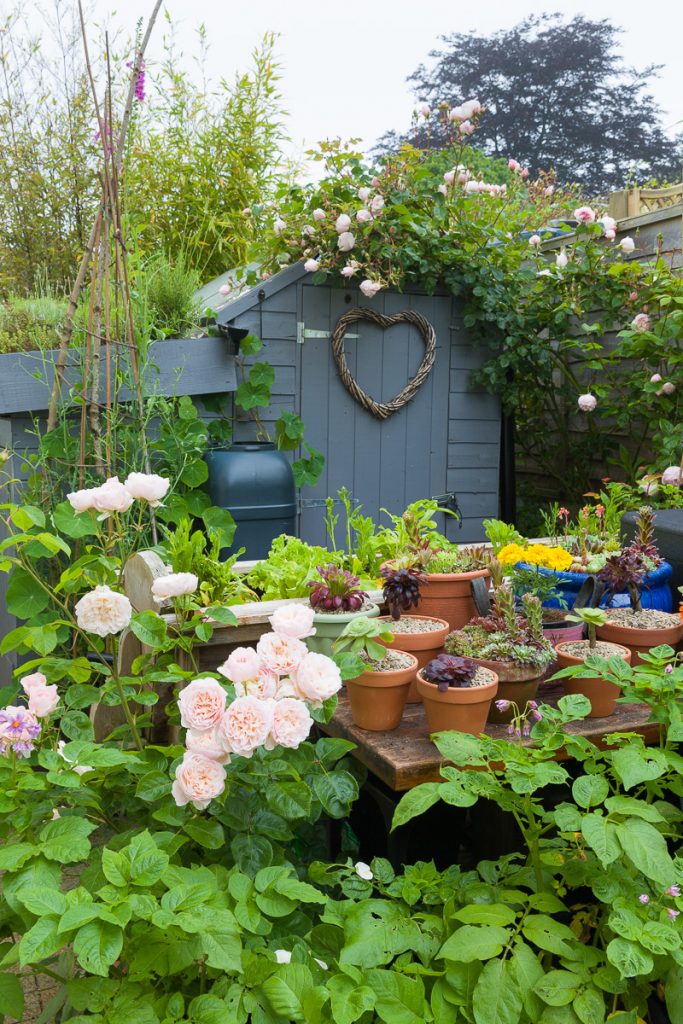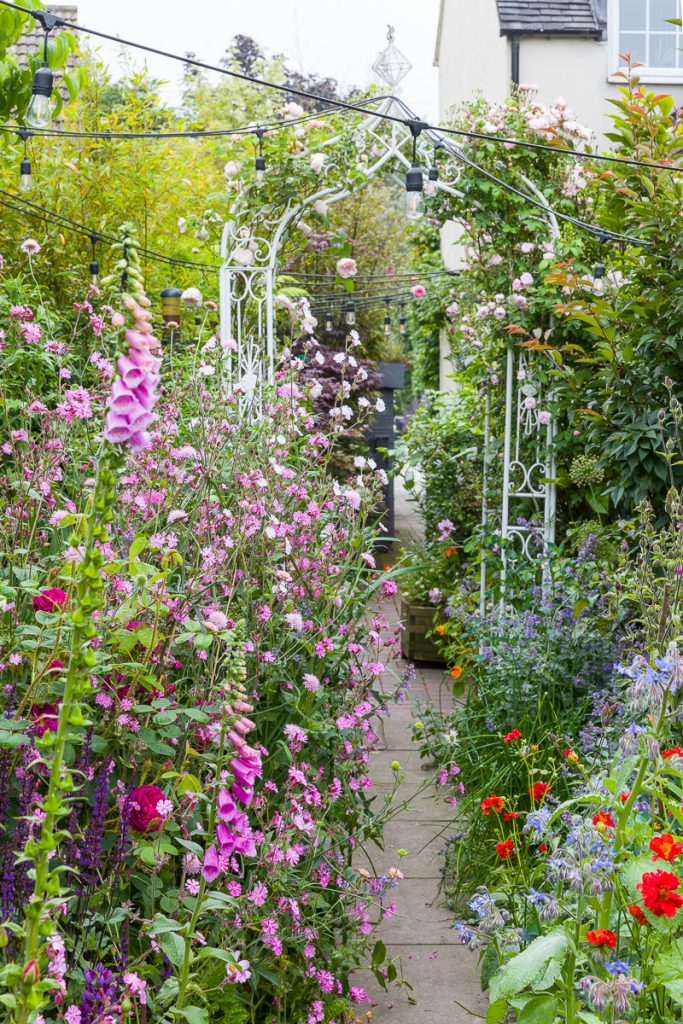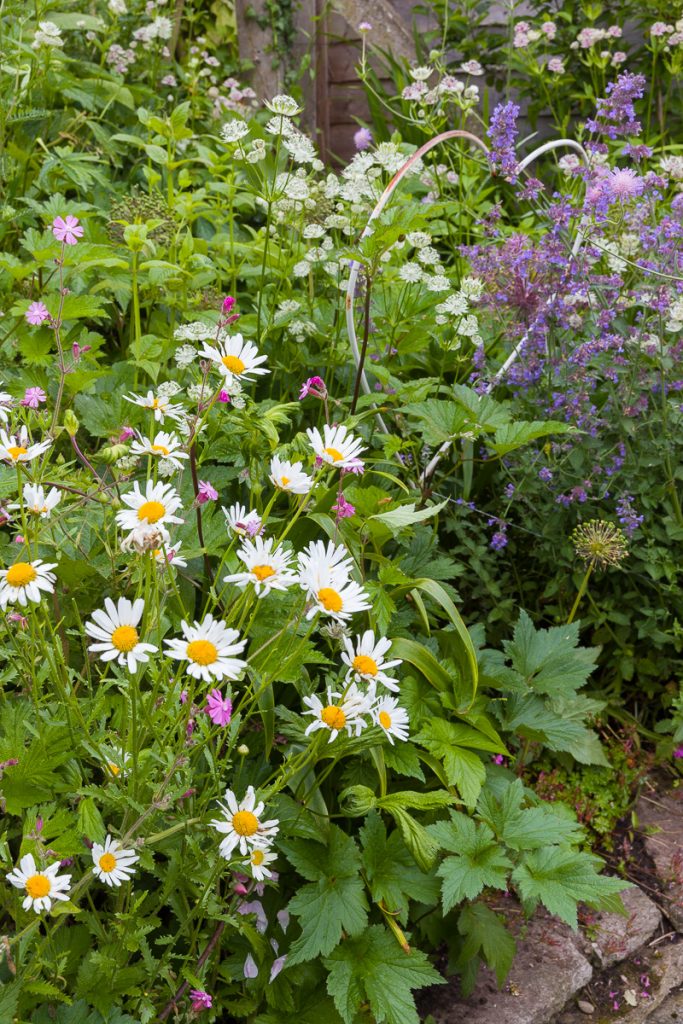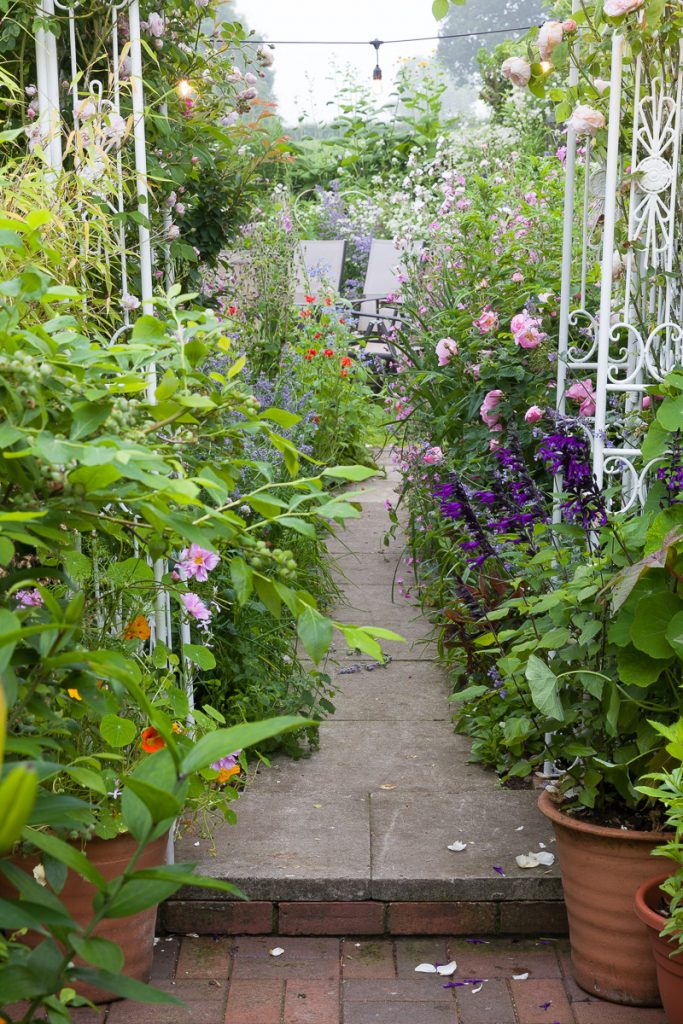153 Willoughbridge: A festival of flowers

John Butcher’s garden at 153 Willoughbridge in Market Drayton, Shropshire, opens for the National Garden Scheme on 15 and 16 July 2023. An article, published in the RHS Magazine ‘The Garden’ – and reproduced here – tells the story behind this remarkable small space:
Only the postman uses the front door at John Butcher’s rural home near Market Drayton, Shropshire. Plants have blocked access to all but the letterbox. ‘Visitors have to come down the side of the house,’ he says. ‘It’s a fragrant jungle down there, buzzing with insect life. It may be a cliché, but if you build it, they will come.’
In the five years since he transformed it, John has seen wildlife flock to his modest-sized plot. ‘I rented the house for three years before buying it,’ he says. ‘This gave me the ideal opportunity to observe the site through the seasons before breaking ground, while keeping my plant collection in pots. ‘The back of the garden was largely laid to lawn with a path leading to a shed,’ says John. ‘I started by repurposing the shed into a log store and lean-to, both with green roofs, and recentering the path. I took up the lawn on either side to make borders, which I’ve extended pretty much every year, and our Victorian-style greenhouse arrived two years ago. The lawn is now so small it’s not worth mowing any more, so I’ll remove it altogether next winter.’
Conscious of the threatened state of insect populations, and in particular the plight of bees (he has two hives of his own in a different location), John tries to have something flowering every month of the year. However, it is summer when the garden really comes to life. An abundance of blooms swells from the borders either side of the path, belying how narrow they are. Nepeta ‘Six Hills Giant’ and geum cultivars froth around your feet beside Salvia nemorosa ‘Caradonna’ agm, lupins and borage. Cosmos Sensation Series and Cupcakes Series vie with foxgloves reaching up through it all, while roses tumble down from the archway. It’s like walking through a tunnel of flowers where bees, butterflies and hoverflies buzz and flit among the blossoms. As the path opens out onto the tiny lawn and seating area, the borders continue around the edge, with espaliered fruit trees and climbers making the most of the vertical space. Astrantias, crocosmias, monardas, alliums and roses spill over from the borders. Wherever there’s room for plants, there are plants. Around the sheltered kitchen door is a collection of acers, bananas, jasmine, lilies and a prized tree fern – all in containers. Together they create a tropical corner, in contrast to the cottage-style character of the back garden.
Constant juggling is required in this small space: ‘When I bought a new acer it took three hours to get it into place,’ says John. ‘Every time I move one pot I have to move another 10 to make room.’ The front of the house is south-facing. ‘This is where I keep my Provence-style collection of pots, climbers and a small bed of lavender, agastache, Stipa gigantea and Molinia ‘Karl Foerster’,’ he says. ‘The soil is light and drains fast. There’s a sand and gravel quarry over the road – if I dig a couple of feet down it’s pure sand, like a beach. I have to add loads of home-made compost to the borders every year, and choose plants that can cope with the soil.’
Immersive planting
As a child John remembers feeling dwarfed when walking through meadows of tall grasses and flowers. ‘It’s that effect I’m trying to recreate,’ he says. ‘Friends complain they can’t get down the path, but I love pushing through the plants.’ An early influence was Christopher Lloyd’s planting at Great Dixter in East Sussex. Closer to home John loves to visit Wollerton Old Hall and Arley Hall for further inspiration.
‘I’ve always wanted to garden harmoniously with nature, ever since I first picked up a trowel aged 12,’ says John. ‘We’d been learning about climate change at school, so I thought I’d try and help the planet by growing some plants. Now, my bug hotels attract solitary bees and wasps, and birds flock to my feeders and nest in the garden. While filling a gap in the bin store’s green roof last summer I discovered a bumblebee nest. It makes gardening like this feel so worthwhile.’
John’s perennial borders are packed with plants, and this means that they provide ample shelter for amphibians and small mammals, too. There’s always the chance of finding something new in the garden: ‘Last year we had a hummingbird hawk moth for the first time.’
John has been buoyed by the positive response to his garden both on social media and at his first open garden last summer. ‘Visitors love all the ideas to promote biodiversity. It goes to show what’s possible in even the smallest garden.’
John’s top tips for gardening with nature
1. Ladybirds love to shelter in old crocosmia growth, so I leave it standing until spring.
2. Bees prefer single flowers such as cosmos, which are easier to access.
3. Bug hotels don’t have to be fancy – a bundle of cut-up bamboo canes is a great habitat.
4. Regular deadheading helps perennials and annuals last, providing valuable late nectar into autumn.
5. Let nature do the work – I dig up self-sown foxgloves from the gravel drive and move them to the borders rather than sow them myself.
The details
153 Willoughbridge, Minn Bank, Market Drayton, Shropshire TF9 4JQ
Size: 5.5 x 13.5m (18 x 44ft).
Soil: free-draining, sandy.
Age: five years.
Open: 15 and 16 July for National Garden Scheme (click here for details); other visits ‘By Arrangement’ from May 2023 to Sep 2023 for groups of between 1 and 40.
Maintenance
John Butcher describes his gardening style as ‘thrive or die’. Plants are packed in, which leaves no space for weeds. They also therefore tend to support each other, although he does use some takes and string to keep them from collapsing onto the path. In spring he sows annuals and finishes cutting back herbaceous perennials, pruning and mulching the borders. John spends two to three hours a day through summer deadheading and watering. In late summer he takes cuttings of tender perennials, then allows himself a rest until midwinter.
Follow John on Instagram: @_thebeegardener_
Images: courtesy Joe Wainwright
Words: Holly Farrell
Reproduced with permission from The Garden © RHS 2022

















